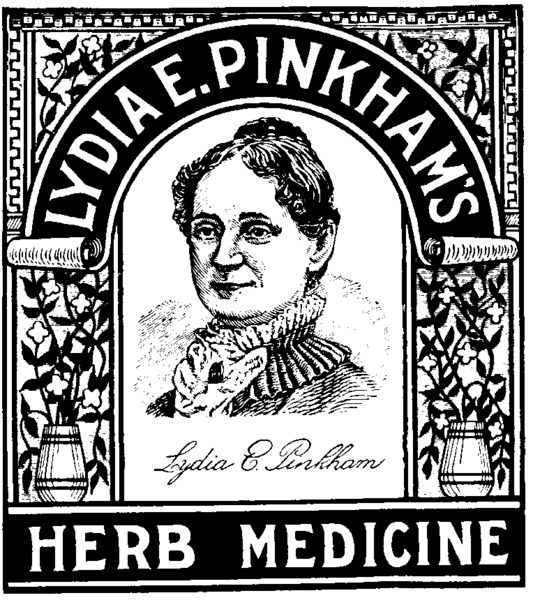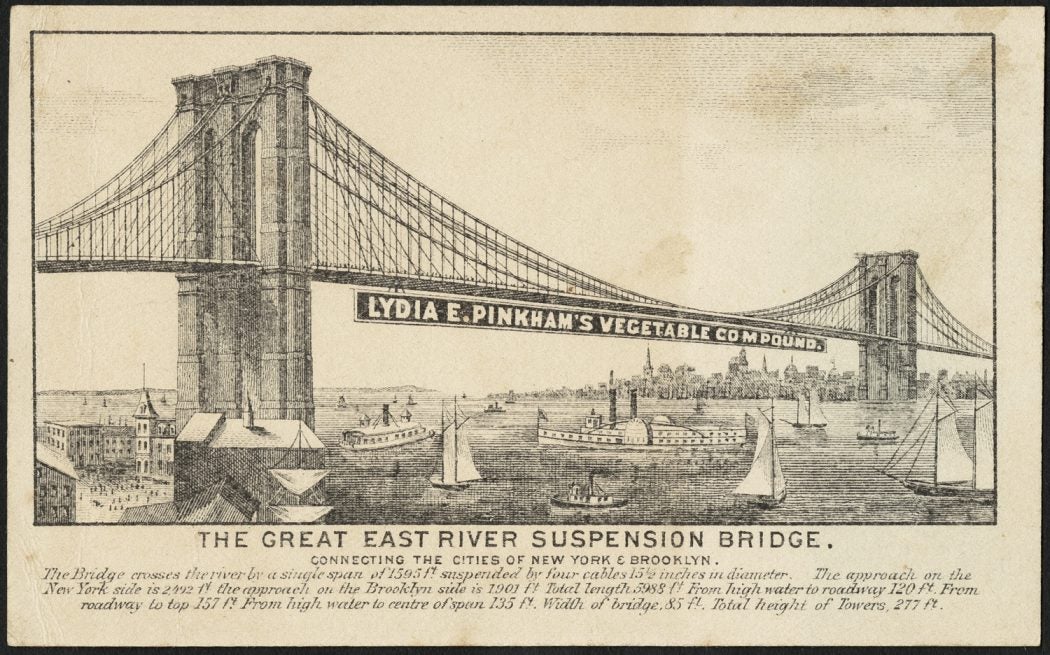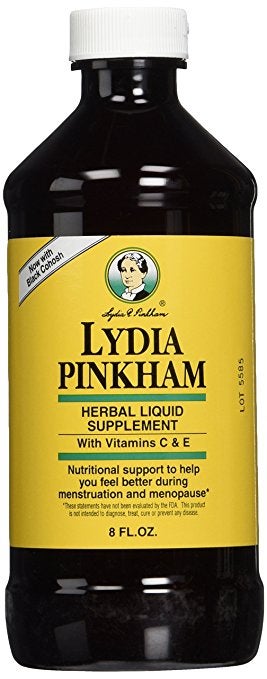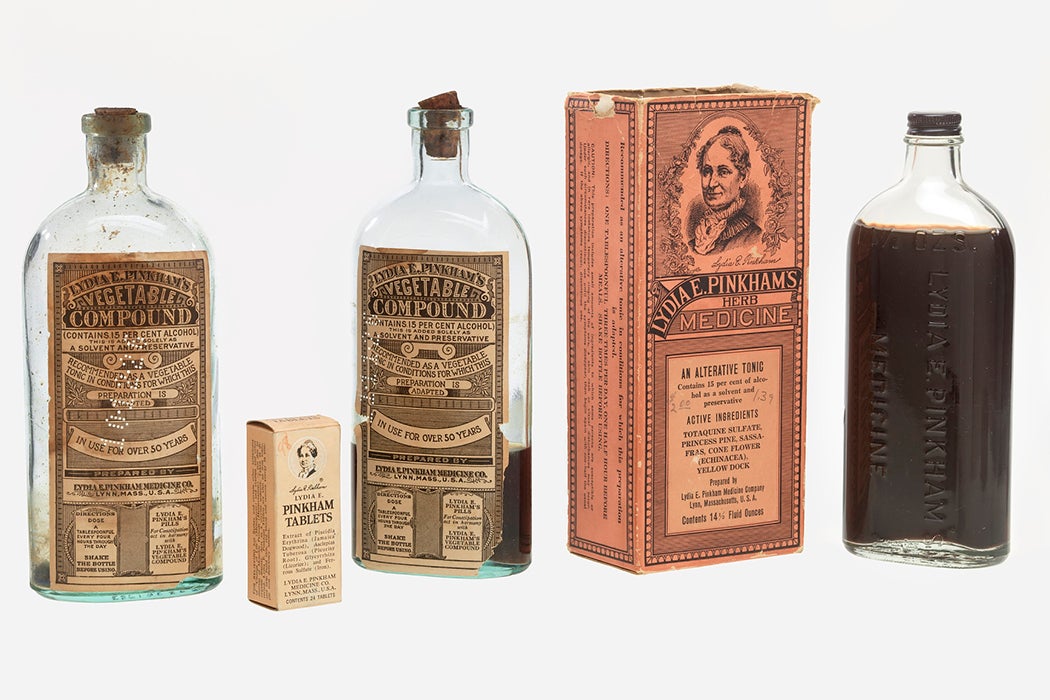You may not recognize her face, but for nearly a hundred years, the grandmotherly countenance of Lydia E. Pinkham appeared in so many newspapers, advertisements, trade cards, and freely distributed pamphlets that contemporaries compared her to Queen Victoria, the Mona Lisa, and Lady Liberty. Pinkham was the developer of an immensely popular, if questionably effective, herbal remedy for “female complaints” called Lydia E. Pinkham’s Vegetable Compound. From its beginnings in 1875 until today—yes, the compound is still being produced—Pinkham’s cure for all manner of womanly woes, including prolapsed uterus, cramps, hot flashes, and pregnancy-related issues, has earned her both scorn and praise. She probably deserved a bit of both.

Like Queen Victoria, Lydia Estes Pinkham was born in 1819. She hailed from a large, middle-class Quaker family in Lynn, Massachusetts, and, unusually for the time, she was educated. The Estes clan was very much a part of the New England wave of social reform that promoted abolition, temperance, and women’s rights. They were friendly with Frederick Douglass, and both Susan B. Anthony and Mary Baker Eddy likely were acquaintances, living nearby. Pinkham, who became a schoolteacher, felt so strongly about slavery that she left the Quaker faith because its platform was not firm enough. At 24, she married Isaac Pinkham, a widowed shoe manufacturer and land speculator who shared her interest in progressivism.
Pinkham left teaching to become a mother. Four of her children survived—three boys and one girl—and it was during this time, according to her biographer, Sammy R. Danna, that she became well-known among her neighbors for her homemade remedies. She kept a personal notebook called “Medical Directions for Ailments,” and a well-thumbed copy of John King’s American Dispensatory, a book first published in 1854 that provides an extensive list of herbs and their medical uses. (King also published a book on women’s diseases in 1858.)
“It was not uncommon at all for women to mix their own herbs and to do herbal remedies… or for some women in communities to be known for this,” said Tori Barnes-Brus, an associate professor of sociology at Cornell College in Mount Vernon, Iowa, who has worked extensively in the Pinkham company records at the Schlesinger Library.
But the real turning point for Pinkham and her family occurred when Isaac, whose fortunes were mercurial, was offered a secret recipe in exchange for money owed to him. As the story goes, this formula, which became the famous Vegetable Compound, cooked up by Lydia on her stove, contained unicorn root, life root, black cohosh, pleurisy root, and fenugreek seed preserved in 19 percent alcohol.
“Some of the things in the compound, like black cohosh, are still things that women who turn to alternative medicine would use today for hot flashes, or to relieve symptoms of menopause,” Barnes-Brus said. Indeed, today’s nursing mothers might also recognize fenugreek as an herbal supplement promoted to increase milk supply.
Whether Pinkham’s potion cured anything or merely illustrated the placebo effect, her reputation grew to the point that, according to her biographers, ladies began to travel to Lynn to buy her brew. She was wary of commercialization, but the Panic of 1873 had ruined Isaac, and the family decided to give it a go with the Vegetable Compound in 1875, touting it as “A Sure Cure for Prolapsus Uteri or falling of the Womb, and all Female Weaknesses, including Leucorrhea, Painful Menstruation, Inflammation, and Ulceration of the Womb, Irregularities, Floodings, etc.”
Patent medicines had become a big business in the post–Civil War era, as they not only promised relief from just about everything that ailed, but typically did so with a dose of alcohol large enough to ease aches and mask symptoms in the short term. “Country cures,” like vegetable pills and sarsaparilla-based tonics, based on Native American lore, were rampant as cure-alls, claiming to treat small pox, yellow fever, consumption, cancer, you name it. They were cheap and didn’t require a surgeon. (A hospital visit in the pre–Germ Theory days held a high probability of exposure to infection and death.)
Women especially preferred to rely on home remedies. According to Pinkham biographer Sarah Stage, doctors of the time would examine female patients under their skirts to preserve propriety, making serious diagnosis nearly impossible. So women turned to other women—like Pinkham—for advice and aid. As Stage writes, “In the absence of readily available, valid medical therapies the Vegetable Compound made sense.”
(A selection of Pharmaceutical Trade Cards from the New York Academy of Medicine from Pinkham’s era)
Clearly Pinkham understood the woman-to-woman appeal of her product, and it is entirely plausible that her initial foray into pharmacology was rooted in her progressive ideas about women and women’s health and teaching women how to care for their bodies. But in order to make money, marketing and selling the Vegetable Compound would take precedence, and she delegated these tasks to her two middle sons, Will and Dan. She wrote the company’s first piece of advertising, a four-page pamphlet called “Guide for Women”—free health guides and textbooks would become a staple of their advertising efforts—which Dan circulated via his mail route before setting off for Brooklyn to try hawking the compound in the big city.
In Brooklyn, Dan devised several grand plans, like littering the parks and cemeteries with postcard-like cards that featured faux inscriptions written on them, as if one friend were telling another about this amazing new remedy but sadly misplaced the note before mailing it. The cards he had made showing the new Brooklyn Bridge draped end to end with a banner hyping the compound—which never actually happened—were his most successful.
Dan also thought they should add kidney complaints to the list of things the compound claimed to cure. Then he proposed trading on their homey, New England–ness, which led to the fateful scheme to use his mother’s portrait in the advertisements—the compassionate, idealized grandmother. His brother, Will, hired an agent to secure newspaper advertising space, and thus the face of Lydia E. Pinkham went as close to viral as possible within the Victorian media landscape. College boys sang drinking songs about her. Sales boomed. Hers was the first woman’s likeness to be used in advertising, and it worked better than anyone could have imagined. Business students and historians still cite Pinkham when discussing brand loyalty and, in The Rise of Advertising in the United States by Edd Applegate, the effect of newspaper advertising.
The company’s short-lived high took a tumble when both Dan and Will died of tuberculosis within two months of each other in 1881, followed by Lydia in 1883, after a paralytic stroke. That left the elder brother, Charles, and his sister, Aroline, and their spouses in charge of the business. It also left the business without its namesake or the lady in its logo. But the Lydia E. Pinkham Medicine Co. endured, capitalizing on Lydia’s image and answering correspondence in her name. They began to rely on less-than-scrupulous ad agents to propel the company forward.

Slowly, the list of symptoms that the Pinkham tonic might quell increased. In 1911, when the British Medical Journal analyzed the composition of “Certain Secret Remedies” related to “women’s complaints,” it noted “a greater number of nostrums of this class than of almost any other, and this is no doubt due to the specially remunerative nature of the business.” The Vegetable Compound by this point marketed itself as a “cure in all cases of irregularity, faintness, headaches, chlorosis [anemia], megrims [low spirits], displacements, periodic bearing-down pains, dizziness, palpitations, depression, pains in the back and those dull and listless days when you feel fit for nothing.” The report drew attention to the high alcohol content and the lack of “any active principle.”
And yet the product line expanded. The company continued to produce pamphlets and guides, such as Yours for Health, Lydia E. Pinkham’s Private Text-Book, and oddly, Landmarks of New England, all printed (and reprinted) for the purpose of plugging Pinkham goods, which by the early twentieth century had come to encompass liver pills, blood purifier, sanative wash (douche), pills for constipation, and mouthwash.
Its message had transformed, too, focusing on the concept of the “ideal wife”—that is, one who is not ill and not a “drag upon her husband.” According to Barnes-Brus, who is currently working on a book on this topic, “You have men that are writing this copy and constructing this notion of womanhood and motherhood in an era when there are very specific ideas about womanhood and motherhood… these messages that are both reproducing and supporting the broader cultural understandings of what women should be.” Through its ubiquitous advertising and free pamphlets, the company became “a social authority on women’s reproduction.”

There were setbacks when the FDA required modifications, both to the formula and to the labeling, but well into the 1940s and ’50s, the Lydia E. Pinkham Medicine Co. shifted shape enough to keep up. It peddled peppy motherhood until—with its aging customer base and the rise of big pharma—it was bought out by Cooper Laboratories for $1 million in 1968. It was turned over twice more, and is now manufactured by Numark Brands as Lydia Pinkham Herbal Supplement, though the original formulation has evolved. It retains Lydia’s pleurisy root and black cohosh, but the other ingredients have been swapped out for motherwort, gentian, Jamaican dogwood, licorice, and dandelion.
The packaging has also been altered—Lydia’s sweet, modernized visage is still featured, alongside clear warnings that the company’s claim to manage menstrual and menopausal symptoms has “not been evaluated by the FDA,” and additionally, that the “product is not intended to diagnose, treat, cure or prevent any disease.” According to Danna’s biography, a “million dollars’ worth of the potion is sold every year on the Internet and by word of mouth.”
Was Lydia E. Pinkham the queen of quackery? Or a pioneer in alternative medicine? Considering this question requires us to separate the woman from the company that flourished under her name (and face). Lydia’s belief that her herbal tincture could repair a prolapsed uterus or treat ovarian tumors was probably no more misguided than many of the therapies and medicines of the time (e.g., bloodletting, cocaine toothache drops, and radioactive water). But the company that emerged after her death became larger than life, and its mass-market approach fits the profile of “patent medicine huckster” in the ever-increasing list of ailments it could assuage, and in the way that it actively, if not nefariously, tried to shape women’s ideas about their bodies.
Perhaps, after all, Lydia E. Pinkham was just a woman of her time, trying to fulfill a need. As Stage put it, “The story of her life, like her famous portrait, has been touched and retouched until the actual woman has become obscured.”











